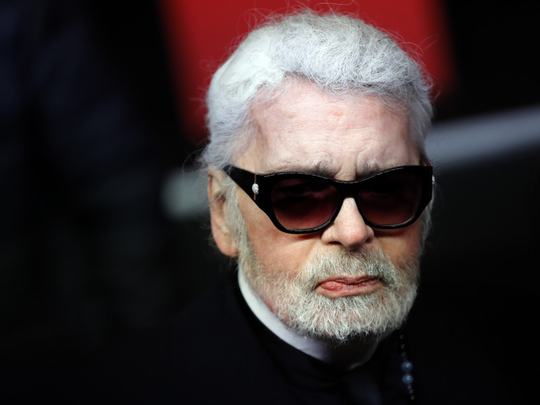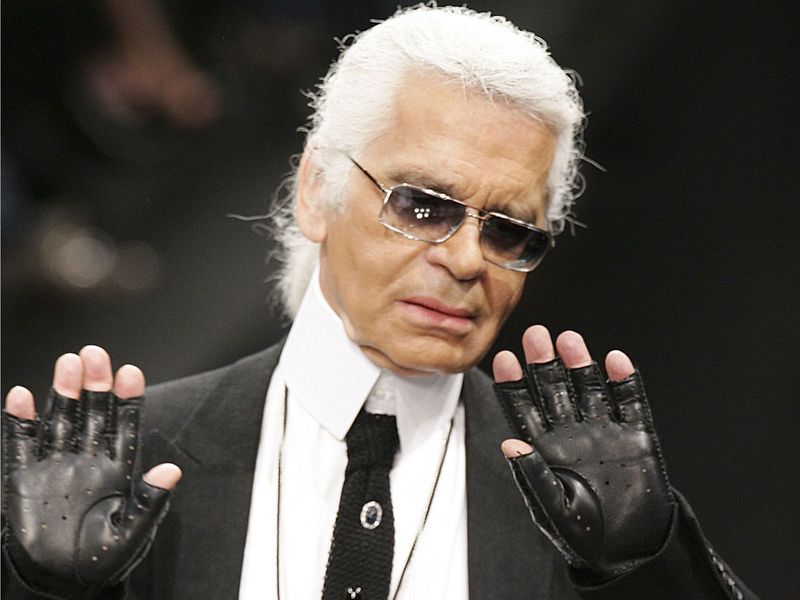
PARIS: Karl Lagerfeld enjoyed the stature of a deity among mortals in the world of fashion, where he stayed on top for well over half of a century and up to his death, at an age almost nobody apart from himself knew with to-the-day precision.
The German designer was best known for his association with France’s Chanel, dating back to 1983.
The brand, the legend now goes, risked becoming the preserve of moneyed grannies before he arrived, slashing hemlines and adding glitz to the prim tweed suits of what is now one of the world’s most valuable couture houses.
But Lagerfeld, who simultaneously churned out collections for LVMH’s Fendi and his eponymous label — an unheard of feat in fashion — was almost a brand in his own right.
Sporting dark suits, white, pony-tailed hair and tinted sunglasses in his later years that made him instantly recognisable, an irreverent wit was also part of a carefully crafted persona.
'It's like a mask'
“I am like a caricature of myself, and I like that,” runs one legendary quote attributed to him, and often recycled to convey the person he liked to play.
“It is like a mask. And for me the Carnival of Venice lasts all year long.” His artistic instincts, business acumen and commensurate ego combined to commercially triumphant effect in the rarefied world of high fashion, where he was revered and feared in similar proportions by competitors and top-models.
A refusal to look to the past was one of his biggest assets, those who knew him said.
The designer mingled with the young and trendy until the last, pairing up with 17-year-old catwalk darling Kaia Gerber, daughter of Cindy Crawford, for a collaboration released by his Karl Lagerfeld brand in 2018.
His cat Choupette moved with the times too: the white-haired Birman, described by her social network minders as “daughter of Karl Otto Lagerfeld”, has more than 100,000 Instagram photo-network followers and a publishing deal.
Yet Lagerfeld also stood out as a craftsman. An accomplished photographer, he drew his own designs by hand, an increasingly rare phenomenon in fashion. Behind the facade, he was known for his erudition and penchant for literature, and he devoured the world’s leading newspapers daily.
Kaiser Karl
Though he long enjoyed befuddling interviewers by citing different years of birth, the one deemed the most reliable is Sept. 10, 1933. Lagerfeld — dubbed “Kaiser Karl” and “Fashion Meister” among a whole host of media monikers — was born in Hamburg to a German mother and a Swedish father who imported condensed milk.
He spent early childhood tucked away from war in the 1,200-acre family estate in Bavaria and had a French tutor.
The big breakthrough came shortly after a move to Paris when, in 1954, he drew a wool coat that won a prize and landed him an apprenticeship with designer Pierre Balmain.

Yves Saint Laurent, who went on to found his namesake label, won the dress prize. The two became fierce competitors and even rivals in love at one point, chasing the affections of late Parisian society figure Jacques de Bascher.
Saint Laurent, who died in 2008, became the enfant cheri of high society and Lagerfeld leader of a wild-child younger group.
He first found real success in the mid-1960s with Chloe, the fashion label now owned by Switzerland’s Richemont and to which he was connected off and on until 1997.
But it was Chanel that propelled him to rock-star status, as he sexed up the brand and lifted its profile with grandiose runway shows. In the past year these have featured a full-scale beach and an enormous replica ship.
Harsh tongue
Lagerfeld was as harsh with his fashion models as he was searingly critical of anyone he considered “not trendy”. He fired his closest female friend, former Chanel model Ines de la Fressange, in 1999 after she agreed to pose as Marianne, France’s national symbol, without asking him first.
Occasionally his sharp tongue has stirred controversies, though he also had a flair for a good soundbite.
In a rare climbdown, he half-apologised to Oscar-winner movie actress Meryl Streep after once suggesting she had refused to wear a dress designed by him at an awards ceremony in favour of another she wanted to be paid to wear.
Lagerfeld, who moonlighted as a cartoonist in Germany’s Frankfurter Allgemeine Zeitung, took a dig at Chancellor Angela Merkel’s pro-refugee stance in a 2017 sketch that blamed her for helping a far-right party gain parliamentary seats.
The designer was not afraid of breaking the mould within often-pompous couture circles. He teamed up with high street brand H&M in 2004 for limited edition collections, a move that raised eyebrows and was then quickly copied by others.
His appearance changed over the years along with his affectations, such as a fan he at one time carried and fluttered incessantly.
Known to adore Diet Coke, Lagerfeld said he shed weight in the early 2000s to fit into the razor-thin suits brought in by Christian Dior’s then menswear designer Hedi Slimane. In rare moments when he was not working, Lagerfeld retired to one of his many homes in Paris, Germany, Italy or Monaco, all of them lavish carbon copies of 18th-century interiors.
The wit and wisdom of Karl Lagerfeld: his best quotes
— On himself —
“I am very much down to earth. Just not this earth.”
— On pyjamas —
“Everybody should go to bed dressed like they have a date at the door.”
— On intellectuals —
“I hate intellectual conversation with intellectuals because I only care about my opinion.”
— On Chanel —
“What I do Coco would have hated. The label has an image and it’s up to me to update it. I do what she never did. I had to go from what Chanel was to what it should be, could be, what it had been to something else.”
— On his secret —
“I am a sort of vampire, taking the blood of other people.”
— On retirement —
“Why should I stop working? If I do I’ll die and it’ll all be finished.”
— On sports clothing —
“Whoever wears running pants has lost control over his life.”
— On being a legend —
“A sense of humour and a little lack of respect: that’s what you need to make a legend survive.”
— On mobile phones —
“I send notes. I’m not a chambermaid whom you can ring at every moment. Today, you know, most people act like they work at a switchboard in a hotel.”
— On creating —
“I have a sort of Alzheimer’s for my own work, which I think is a very good thing. Today too many people remember what they did — just forget it all and start again.”
Karl Lagerfeld: A life in dates
PARIS: Here are some key dates in the life of German fashion designer Karl Lagerfeld, who has died at the age of 85:
— September 10, 1933: Born in Hamburg, though he was later known to knock a few years off his age. His father ran an evaporated milk company.
— 1952: Moves to Paris to complete his education.
— 1954: Wins the prestigious Woolmark prize, jointly with Yves-Saint Laurent, awarded to outstanding fashion talents.
— 1955-1962: Works as an assistant to French fashion designer Pierre Balmain.
— 1963-1984: Artistic director for Chloe.
— 1965: Is appointed artistic director for Fendi.
— 1983: Also becomes artistic director for Chanel.
— 1984: Lagerfeld launches his own fashion label, under his own name.
— 1989: His long-time partner Jacques de Bascher, a French aristocrat, dies of AIDS.
— 1999: Ordered to pay 13.3 million euros ($15.6 million) in back taxes by French authorities.
— 2000: He sells his 18th-century art collection for 21.2 million euros.
— 2004: Designs a capsule collection for low cost retail chain H&M. It goes on to lift the company’s monthly sales by a quarter.
AFP












